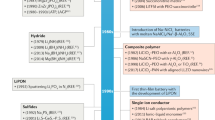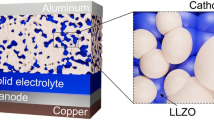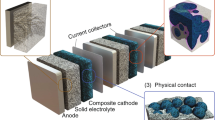Abstract
All-solid-state Li-ion batteries promise safer electrochemical energy storage with larger volumetric and gravimetric energy densities. A major concern is the limited electrochemical stability of solid electrolytes and related detrimental electrochemical reactions, especially because of our restricted understanding. Here we demonstrate for the argyrodite-, garnet- and NASICON-type solid electrolytes that the favourable decomposition pathway is indirect rather than direct, via (de)lithiated states of the solid electrolyte, into the thermodynamically stable decomposition products. The consequence is that the electrochemical stability window of the solid electrolyte is notably larger than predicted for direct decomposition, rationalizing the observed stability window. The observed argyrodite metastable (de)lithiated solid electrolyte phases contribute to the (ir)reversible cycling capacity of all-solid-state batteries, in addition to the contribution of the decomposition products, comprehensively explaining solid electrolyte redox activity. The fundamental nature of the proposed mechanism suggests this is a key aspect for solid electrolytes in general, guiding interface and material design for all-solid-state batteries.
This is a preview of subscription content, access via your institution
Access options
Access Nature and 54 other Nature Portfolio journals
Get Nature+, our best-value online-access subscription
$29.99 / 30 days
cancel any time
Subscribe to this journal
Receive 12 print issues and online access
$259.00 per year
only $21.58 per issue
Buy this article
- Purchase on Springer Link
- Instant access to full article PDF
Prices may be subject to local taxes which are calculated during checkout






Similar content being viewed by others
Data availability
The datasets generated during and/or analysed during the current study are available from the corresponding authors on reasonable request.
References
Kim, J. G. et al. A review of lithium and non-lithium based solid state batteries. J. Power Sources 282, 299–322 (2015).
Zhang, Z. et al. New horizons for inorganic solid state ion conductors. Energy Environ. Sci. 11, 1945–1976 (2018).
Janek, J. & Zeier, W. G. A solid future for battery development. Nat. Energy 1, 16141 (2016).
Zheng, F., Kotobuki, M., Song, S., Lai, M. O. & Lu, L. Review on solid electrolytes for all-solid-state lithium-ion batteries. J. Power Sources 389, 198–213 (2018).
Fergus, J. W. Ceramic and polymeric solid electrolytes for lithium-ion batteries. J. Power Sources 195, 4554–4569 (2010).
Yu, C., van Eijck, L., Ganapathy, S. & Wagemaker, M. Synthesis, structure and electrochemical performance of the argyrodite Li6PS5Cl solid electrolyte for Li-ion solid state batteries. Electrochim. Acta 215, 93–99 (2016).
Famprikis, T., Canepa, P., Dawson, J. A., Islam, M. S. & Masquelier, C. Fundamentals of inorganic solid-state electrolytes for batteries. Nat. Mater. 18, 1278–1291 (2019).
Kamaya, N. et al. A lithium superionic conductor. Nat. Mater. 10, 682–686 (2011).
Ohta, S., Kobayashi, T. & Asaoka, T. High lithium ionic conductivity in the garnet-type oxide Li7−XLa3(Zr2−X, NbX)O12 (X = 0–2). J. Power Sources 196, 3342–3345 (2011).
Boulineau, S., Courty, M., Tarascon, J.-M. & Viallet, V. Mechanochemical synthesis of Li-argyrodite Li6PS5X (X = Cl, Br, I) as sulfur-based solid electrolytes for all solid state batteries application. Solid State Ion. 221, 1–5 (2012).
Kato, Y. et al. High-power all-solid-state batteries using sulfide superionic conductors. Nat. Energy 1, 16030 (2016).
Lotsch, B. V. & Maier, J. Relevance of solid electrolytes for lithium-based batteries: a realistic view. J. Electroceram. 38, 128–141 (2017).
Tian, Y. et al. Compatibility issues between electrodes and electrolytes in solid-state batteries. Energy Environ. Sci. 10, 1150–1166 (2017).
Zhu, Y., He, X. & Mo, Y. Origin of outstanding stability in the lithium solid electrolyte materials: insights from thermodynamic analyses based on first-principles calculations. ACS Appl. Mater. Interfaces 7, 23685–23693 (2015).
Richards, W. D., Miara, L. J., Wang, Y., Kim, J. C. & Ceder, G. Interface stability in solid-state batteries. Chem. Mater. 28, 266–273 (2016).
Han, F., Gao, T., Zhu, Y., Gaskell, K. J. & Wang, C. A battery made from a single material. Adv. Mater. 27, 3473–3483 (2015).
Zhang, W. et al. The detrimental effects of carbon additives in Li10GeP2S12-based solid-state batteries. ACS Appl. Mater. Interfaces 9, 35888–35896 (2017).
Han, F. et al. High electronic conductivity as the origin of lithium dendrite formation within solid electrolytes. Nat. Energy 4, 187–196 (2019).
Han, F., Zhu, Y., He, X., Mo, Y. & Wang, C. Electrochemical stability of Li10GeP2S12 and Li7La3Zr2O12 solid electrolytes. Adv. Energy Mater. 6, 1501590 (2016).
Koerver, R. et al. Redox-active cathode interphases in solid-state batteries. J. Mater. Chem. A 5, 22750–22760 (2017).
Hakari, T. et al. Structural and electronic-state changes of a sulfide solid electrolyte during the Li deinsertion–insertion processes. Chem. Mater. 29, 4768–4774 (2017).
Wenzel, S., Sedlmaier, S. J., Dietrich, C., Zeier, W. G. & Janek, J. Interfacial reactivity and interphase growth of argyrodite solid electrolytes at lithium metal electrodes. Solid State Ion. 318, 102–112 (2018).
Auvergniot, J. et al. Interface stability of argyrodite Li6PS5Cl toward LiCoO2, LiNi1/3Co1/3Mn1/3O2, and LiMn2O4 in bulk all-solid-state batteries. Chem. Mater. 29, 3883–3890 (2017).
Lau, J. et al. Sulfide solid electrolytes for lithium battery applications. Adv. Energy Mater. 8, 1800933 (2018).
Tan, D. H. S. et al. Elucidating reversible electrochemical redox of Li6PS5Cl solid electrolyte. ACS Energy Lett. 4, 2418–2427 (2019).
Deiseroth, H.-J. et al. Li6PS5X: a class of crystalline Li-rich solids with an unusually high Li+ mobility. Angew. Chem. 47, 755–758 (2008).
Auvergniot, J. et al. Redox activity of argyrodite Li6PS5Cl electrolyte in all-solid-state Li-ion battery: an XPS study. Solid State Ion. 300, 78–85 (2017).
Aydinol, M. K., Kohan, A. F. & Ceder, G. Ab initio calculation of the intercalation voltage of lithium-transition-metal oxide electrodes for rechargeable batteries. J. Power Sources 68, 664–668 (1997).
Aydinol, M. K., Kohan, A. F., Ceder, G., Cho, K. & Joannopoulos, J. Ab initio study of lithium intercalation in metal oxides and metal dichalcogenides. Phys. Rev. B 56, 1354–1365 (1997).
Mayo, M., Griffith, K. J., Pickard, C. J. & Morris, A. J. Ab initio study of phosphorus anodes for lithium- and sodium-ion batteries. Chem. Mater. 28, 2011–2021 (2016).
Ramireddy, T. et al. Phosphorus–carbon nanocomposite anodes for lithium-ion and sodium-ion batteries. J. Mater. Chem. A 3, 5572–5584 (2015).
Hakari, T., Nagao, M., Hayashi, A. & Tatsumisago, M. All-solid-state lithium batteries with Li3PS4 glass as active material. J. Power Sources 293, 721–725 (2015).
Deiseroth, H. J. et al. Li6PS5X: a class of crystalline Li‐rich solids with an unusually high Li+ mobility. Angew. Chem. Int. Ed. 47, 755–758 (2008).
Dietrich, C. et al. Local structural investigations, defect formation, and ionic conductivity of the lithium ionic conductor Li4P2S6. Chem. Mater. 28, 8764–8773 (2016).
Dietrich, C. et al. Lithium ion conductivity in Li2S–P2S5 glasses—building units and local structure evolution during the crystallization of superionic conductors Li3PS4, Li7P3S11 and Li4P2S7. J. Mater. Chem. A 5, 18111–18119 (2017).
Murakami, M. et al. Dynamical origin of ionic conductivity for Li7P3S11 metastable crystal as studied by 6/7Li and 31P solid-state NMR. J. Phys. Chem. C 119, 24248–24254 (2015).
Meyer, B. M., Leifer, N., Sakamoto, S., Greenbaum, S. G. & Grey, C. P. High field multinuclear NMR investigation of the SEI layer in lithium rechargeable batteries. Electrochem. Solid State Lett. 8, A145–A148 (2005).
Stöffler, H. et al. Amorphous versus crystalline Li3PS4: local structural changes during synthesis and Li ion mobility. J. Phys. Chem. C 123, 10280–10290 (2019).
Yu, C. et al. Accessing the bottleneck in all-solid state batteries, lithium-ion transport over the solid-electrolyte-electrode interface. Nat. Commun. 8, 1086 (2017).
Zhang, W. et al. (Electro)chemical expansion during cycling: monitoring the pressure changes in operating solid-state lithium batteries. J. Mater. Chem. A 5, 9929–9936 (2017).
Larson, A. C. & Von Dreele, R. B. General Structure Analysis System (GSAS) (Los Alamos National Laboratory, 2004).
Yu, C. et al. Facile synthesis toward the optimal structure-conductivity characteristics of the argyrodite Li6PS5Cl solid-state electrolyte. ACS Appl. Mater. Interfaces 10, 33296–33306 (2018).
Yu, C. et al. Tailoring Li6PS5Br ionic conductivity and understanding of its role in cathode mixtures for high performance all-solid-state Li–S batteries. J. Mater. Chem. A 7, 10412–10421 (2019).
de Klerk, N. J. J., Rosłoń, I. & Wagemaker, M. Diffusion mechanism of Li argyrodite solid electrolytes for Li-ion batteries and prediction of optimized halogen doping: the effect of Li vacancies, halogens, and halogen disorder. Chem. Mater. 28, 7955–7963 (2016).
Kresse, G. & Hafner, J. Ab initio molecular dynamics for liquid metals. Phys. Rev. B 47, 558–561 (1993).
Perdew, J. P., Burke, K. & Wang, Y. Generalized gradient approximation for the exchange-correlation hole of a many-electron system. Phys. Rev. B 54, 16533–16539 (1996).
Blöchl, P. E. Projector augmented-wave method. Phys. Rev. B 50, 17953–17979 (1994).
Fennell, C. J. & Gezelter, J. D. Is the Ewald summation still necessary? Pairwise alternatives to the accepted standard for long-range electrostatics. J. Chem. Phys. 124, 234104 (2006).
Jain, A. et al. The Materials Project: a materials genome approach to accelerating materials innovation. APL Mater. 1, 011002 (2013).
Kang, J., Chung, H., Doh, C., Kang, B. & Han, B. Integrated study of first principles calculations and experimental measurements for Li-ionic conductivity in Al-doped solid-state LiGe2(PO4)3 electrolyte. J. Power Sources 293, 11–16 (2015).
Acknowledgements
The authors thank K. Goubitz, M. Steenvoorden and F. Ooms for their assistance with experiments and C. Robledo for her assistance with the schematic graphic. Financial support is acknowledged from the Netherlands Organization for Scientific Research (NWO) under the VICI grant no. 16122, from the eScience Centre and NWO under the joint CSER and eScience programme for Energy Research grant no. 680.91.087 and from the Advanced Dutch Energy Materials (ADEM) programme of the Dutch Ministry of Economic Affairs, Agriculture and Innovation.
Author information
Authors and Affiliations
Contributions
T.S., A.V. and N.J.J.d.K. carried out the DFT simulations and T.S. and A.V. analysed the data. C.Y. and C.W. synthesized the solid electrolytes. T.S., C.W., V.A. carried out the electrochemical measurements and T.S. and V.A. analysed the data. T.S., V.A. and C.W. carried out the XRD measurements and V.A., T.S. and S.G. analysed the data. V.A. measured and analysed the NMR data. C.Y., E.v.d.M., Y.X. and J.H. carried out preliminary measurements. T.H., I.K. and E.M.K. contributed to the discussion of results. M.W. supervised the project. S.G. and M.W. designed the research. T.S., V.A., S.G. and M.W. wrote the manuscript.
Corresponding authors
Ethics declarations
Competing interests
The authors declare no competing interests.
Additional information
Publisher’s note Springer Nature remains neutral with regard to jurisdictional claims in published maps and institutional affiliations.
Extended data
Extended Data Fig. 1 Molecular dynamics simulations of Li4PS5Cl, Li6PS5Cl and Li11PS5Cl.
a, Radial distribution function (RDF) of the S-S bonds in (de)lithiated LixPS5Cl for x = 4, 6, and 11 during a 400 K DFT-MD simulation. During delithiation an increase in S-S bonds is seen around 2.1 Å, indicating that the formation of S-S bonds originates from the oxidation of S in the argyrodite. On top of the peaks, bonds at corresponding radii are displayed. It is important to realize that the timescale at which these structural transformations can be evaluated is very limited and therefore sluggish transformations fall outside the scope of this evaluation. b, Radial distribution function (RDF) of the P-S bonds of (de)lithiated LixPS5Cl for x = 4, 6 and 11 during a 400 K DFT-MD simulation, For the lithiated phase, Li11PS5Cl, a drop in intensity is observed at r = 2.1 Ả, consistent with breaking P-S bonds in the PS4 groups. This is expected because the P atoms can compensate for the change in valence as a consequence of the lithiation. The MD simulations indicate that the Li4PS5Cl and Li11PS5Cl compositions are extremely unstable, having very low activation barriers towards decomposition. Their instability suggests that these compositions will only occur locally in the material, rapidly initiating local decomposition, which will nevertheless require the associated oxidation or reduction potential predicted by the convex hull shown in Fig. 2b. c, Relaxed structures of LixPS5Cl for x = 4, 6 and 11 after a 400 K DFT-MD simulation. The violet, orange, yellow and green spheres indicate lithium, phosphorous, sulfur, and chlorine respectively.
Extended Data Fig. 2 6Li MAS NMR spectra of the cathodic mixtures and anodic mixtures.
6Li MAS NMR spectra of the cathodic mixtures (a-d) and anodic mixtures (e–g) of Li6PS5Cl in the In|LPSC|LPSC-C and Li-In|LPSC|LPSC-C solid-state batteries respectively. After first charge of the In|LPSC|LPSC-C solid-state cell, formation of LiCl is observed (b). First discharge shows formation at a new resonance frequency corresponding to Li3PS4 (c, d). The solid state cell, which starts from lithiation process (f), results in formation of Li2S, confirmed with the spectrum of the reference Li2S (g).
Supplementary information
Supplementary Information
Supplementary Tables 1–7 and Figs. 1–9.
Rights and permissions
About this article
Cite this article
Schwietert, T.K., Arszelewska, V.A., Wang, C. et al. Clarifying the relationship between redox activity and electrochemical stability in solid electrolytes. Nat. Mater. 19, 428–435 (2020). https://doi.org/10.1038/s41563-019-0576-0
Received:
Accepted:
Published:
Issue Date:
DOI: https://doi.org/10.1038/s41563-019-0576-0
This article is cited by
-
Designing lithium halide solid electrolytes
Nature Communications (2024)
-
Research Progress on the Solid Electrolyte of Solid-State Sodium-Ion Batteries
Electrochemical Energy Reviews (2024)
-
From non-carbon host toward carbon-free lithium-sulfur batteries
Nano Research (2024)
-
Li–Solid Electrolyte Interfaces/Interphases in All-Solid-State Li Batteries
Electrochemical Energy Reviews (2024)
-
Boosting lithium ion conductivity of antiperovskite solid electrolyte by potassium ions substitution for cation clusters
Nature Communications (2023)



